If you’ve decided to install a metal roof, there are some additional choices that you’ll have to make before the installation, including the profile, size, color, and even the paint system type.
Two of the most common paint coating systems in the architectural standing seam roofing industry are polyvinylidene fluoride (PVDF) and silicone modified polyester (SMP).
So, should you choose PVDF or SMP for your metal roof? Well, it depends.
At Sheffield Metals, we’ve been supplying metal sheet and coil products coated in both PVDF and SMP paint systems for over 25 years. We know that there are distinct differences between both of these coatings, which is why it’s critical to know all of the characteristics before you buy.
In this article, we’ll cover:
- PVDF – what it is, the advantages, and the disadvantages
- SMP – what it is, the advantages, and the disadvantages
- Scenarios that can help you choose the right coating
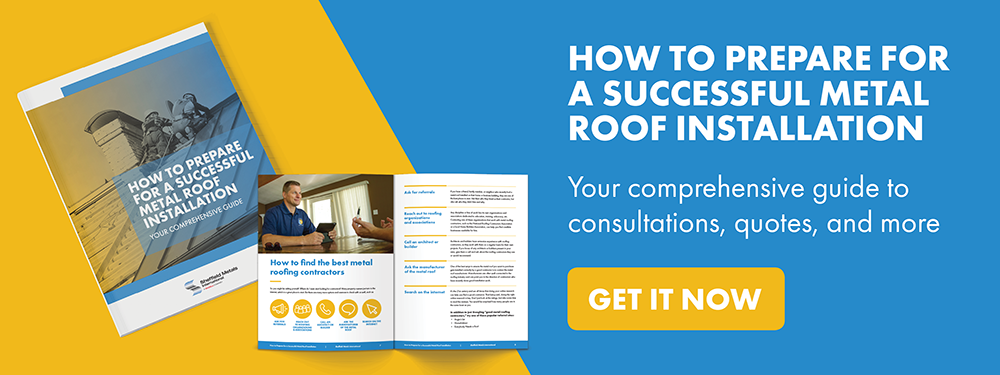
Polyvinylidene Fluoride (PVDF) Paint System Pros & Cons
PVDF is a resin made up of about 70% polyvinylidene thermoplastic fluoropolymer and 30% acrylic. Commonly referred to as Kynar 500® or Hylar 5000®, PVDF resins are the best protective coatings to withstand extreme temperatures, sun exposure, oxygen, humidity, and pollution particles in the atmosphere.
PVDF-coated metal is the most commonly specified and installed material in the architectural standing seam metal roofing industry.
Advantages & Pros of PVDF Paint Systems
Superior color retention
One of the main benefits of PVDF paint systems is that they hold on to their color longer than most other coil coating options. Many home and property owners specifically choose to install a metal roofing system because they know it will last decades without too many signs of degradation — including the appearance.
Carbon-fluorine bonds, like those present in a PVDF resin, are some of the strongest bonds, which makes them “virtually immune to degradation from sunlight, moisture, acids, pollutants, and chemicals.” (Glass Canada) These PVDF resins, in turn, protect the pigments that form the color in the paint system, which is why PVDF metal roofs and walls hold on to their color longer than SMPs and most other paint options.
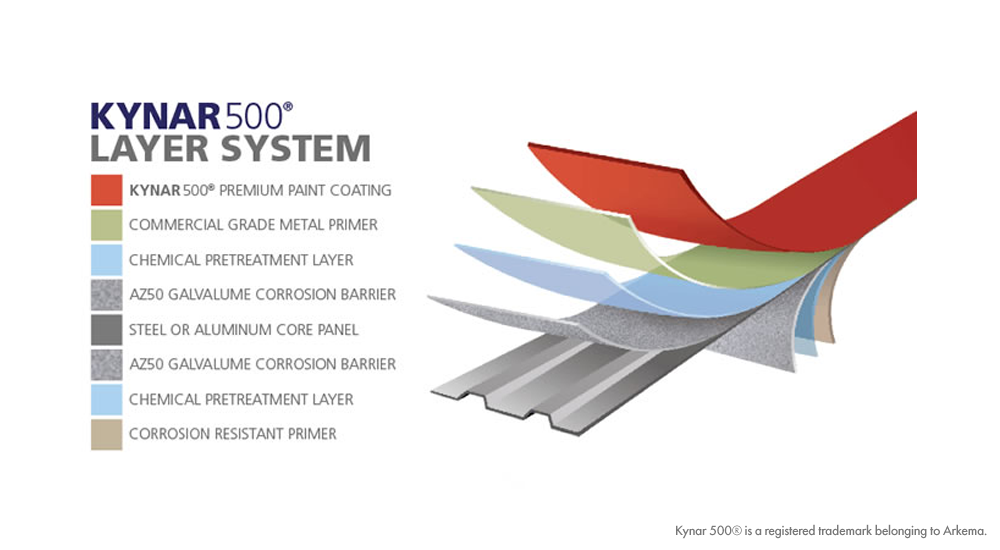
Chalking & fading resistance & better warranty coverage
Every painted metal roofing system will experience chalking and fading in some capacity over time. However, PVDF systems are specifically formulated to resist these occurrences for longer, especially when compared to SMP.
For reference:
- Fading on painted metal roofing or walls occurs when substances like water, pollution, and chemicals in the atmosphere react with the paint’s pigment and diminish the color vibrance.
- Chalking is the whitish residue that can become visible on a painted or coated metal surface over time. As a panel is exposed to sunlight and UV rays, the resin breaks down and degrades. Once the resin starts to break down and the exposure continues, it loses its adhesion to the surface, and those degraded particles begin to turn white. These white chalking particles will become more apparent over time.
On top of the better resistance to chalking and fading, the warranty coverage for PVDF systems is better than most SMP systems. To illustrate how PVDF and SMP paint warranties differ at Sheffield Metals, we’ve put together a basic chart for comparison.
PVDF vs. SMP Warranty Comparison Chart
| Film adhesion length | Fading coverage length | Fading units (the lower the Hunter unit, the better the performance) | Chalking coverage length | Chalking number (the higher the chalking number, the better the performance) | |
| PVDF | 40 years | 30 years | 5 Hunter delta-E units for roofs & walls | 30 years | 8 rating on rating on roofs & walls |
| SMP | 40 years | 30 years | 7 Hunter delta-E units for roofs (horizontal) 5 Hunter delta-E units for walls (vertical) | 30 years | 6 rating on roof panels (horizontal) 8 rating on rating on walls (vertical) |
As you can see on the chart, PVDF and SMP have the same coverage lengths; however, the levels of chalking and fading are better for PVDF. Essentially, you can expect less chalking and fading in the 30-year fading coverage window with PVDF.
High film adhesion integrity
Along with better resistance to chalking and fading, PVDF also has excellent film adhesion integrity. As you can see on the chart above, Sheffield Metals offers a warranty covering cracking, flaking, or peeling (film adhesion) to an extent apparent on ordinary outdoor visual observation for up to 40 years.
Better for bright, vivid colors
As we discussed, PVDF is the best paint system option if you’re looking to install a metal roof or wall in a bright or vivid color, such as Regal Red (which only has chalk and fade coverage for 10 years), Regal Blue, or Terra Cotta. These vivid pigments in PVDF systems will be protected and therefore stay brighter for longer than an SMP system.
Even if you’re not choosing a bright or vivid color for your project and are going with a muted, Earthy, or light shade, the color will hold up great with a PVDF resin protecting it.
Cool metal roofing properties
Cool metal roofing is defined as painted or coated metal products that reflect the sun’s energy to dissipate heat. Many PVDF paint systems used in metal roofing contain innovative solar reflective pigments that make a metal roof system “cool” and therefore help to reduce the heat transferred into a building. According to the Green Building Alliance, this heat transfer reduction can result in total cooling cost energy savings ranging from 7% to 15%. Learn more about cool metal roofing, Solar Reflectance Index (SRI), emissivity, and more in our in-depth cool metal roofing article here.
Disadvantages & Cons of PVDF Paint Systems
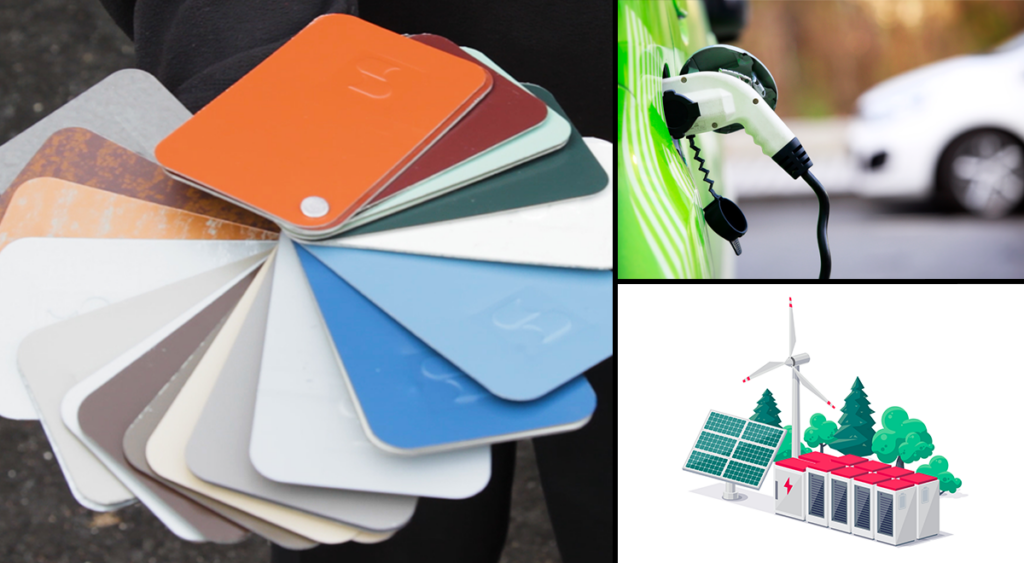
Experiencing demand challenges in 2022
In early 2022, the entire metal roofing market is experiencing a disruption in getting PVDF-coated products due to shifted demands and new expanded uses of PVDF in other industries.
We have an entire article dedicated to this topic, but to recap: PVDF is a product used to produce batteries for electric vehicles (EVs) and battery solutions for renewable energy systems, both of which are in high demand. Battery and EV manufacturers are willing and able to pay higher prices for PVDF than the traditional architectural metal construction industry. This puts PVDF manufacturers in a spot where they’re more inclined to sell to the market that will pay a premium for their products, which is why more PVDF is allocated to the battery and EV manufacturers. Additionally, China is keeping much of its PVDF to assist with battery manufacturing.
In mid-January, nearly all metal roofing suppliers (including Sheffield Metals) that purchase PVDF coatings are now on allocation from their paint suppliers. Essentially, this means that we’re going to be able to continue to get PVDF coatings at the level we’re currently purchasing it, and maybe a little more than we have historically. However, paint suppliers (such as Sherwin-Williams) will not have enough PVDF to take on too many new customers while PVDF supplies are low.
More expensive coating option
One of the most notable disadvantages of PVDF is that it’s already a higher-priced product. On top of that, PVDF is also experiencing significant price increases due to the demand issues described above.
As of early 2022, PVDF costs about 60 to 80% more than SMP and is about 50 to 60% higher in price than 15-16 months ago. Remember, PVDF prices are expected to continue rising, creating a wider pricing gap between SMP and PVDF.
Softer paint system than SMP
Another drawback of PVDF is it’s a softer, more flexible coating system. Flexibility is helpful when it comes to bendability and the forming of panels; however, the softer nature of the coating makes it more susceptible to scratching and scuffing. Contractors and manufacturers have to take extra precautions during the manufacturing, transporting, and installation of PVDF-coated panels, which is often why PVDF material has a PVC film on top of it to preserve the coating until installation.
Luckily, most small scratches can be remedied with PVDF paint pens, which are typically available from your coil supplier.
Silicone Modified Polyester (SMP) Paint System Pros & Cons
SMP, also referred to as silicone-protected or siliconized polyester, is an architectural paint system used to coat metal sheet and coil products. According to Metal Coaters, SMP paint systems blend polyester for weather resistance and silicon for gloss retention into one formula.
For reference, SMP is usually considered a step below PVDF in terms of performance in standing seam metal roofing.
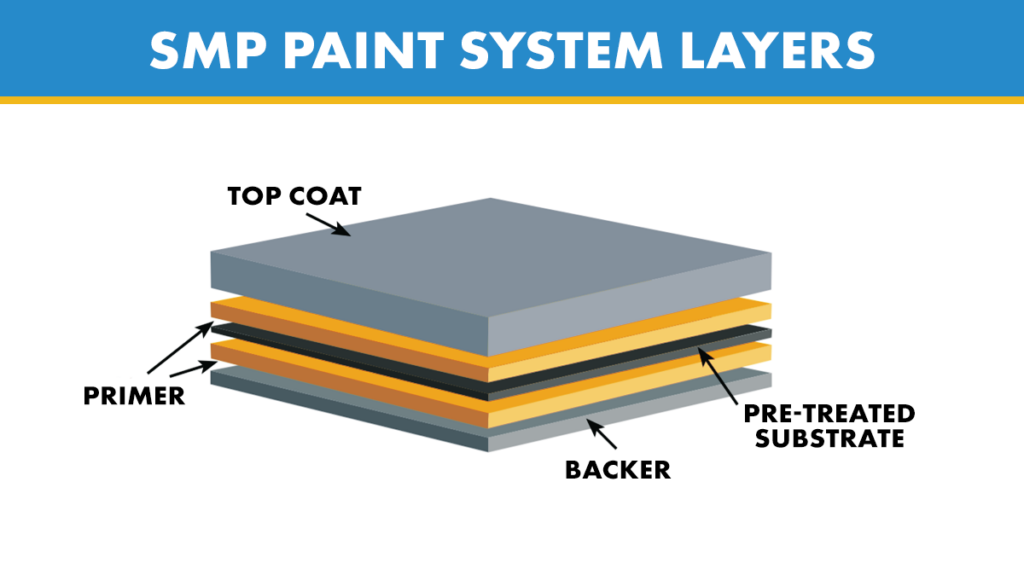
Advantages & Pros of SMP Paint Systems
Superior scratch resistance
One of the most significant benefits of SMP is that it’s a harder paint system than PVDF, which makes SMP-coated material more difficult to scratch. Panels with an SMP paint system can withstand a higher level of improper handling during the manufacturing or installation of a roof. You might even notice that SMP-coated metal often doesn’t have any film on top of it because it’s overall more scratch-resistant.
Film adhesion warranty
Another benefit of SMP paint systems is that the film adhesion part of the paint/finish warranty is usually similar to (or the same as) PVDF. For example, at Sheffield Metals, we offer a warranty covering cracking, flaking, or peeling to an extent apparent on ordinary outdoor visual observation for up to 40 years. This is the same film adhesion coverage available on our PVDF-coated products (see warranty comparison chart above).
Lower cost & more affordable
One of the most notable benefits of SMP is that it comes at a much lower price point than traditional PVDF-coated materials, making it a more affordable option for some standing seam projects. The lower price of SMP is why it’s traditionally used in structural and agricultural metal roofing applications. Recent advancements in SMP formulas have expanded it into more architectural, residential, and commercial projects.
Keep in mind that different SMP paints cost more than others, including those formulated with ceramic pigments for higher fading resistance.
Textured finishes available
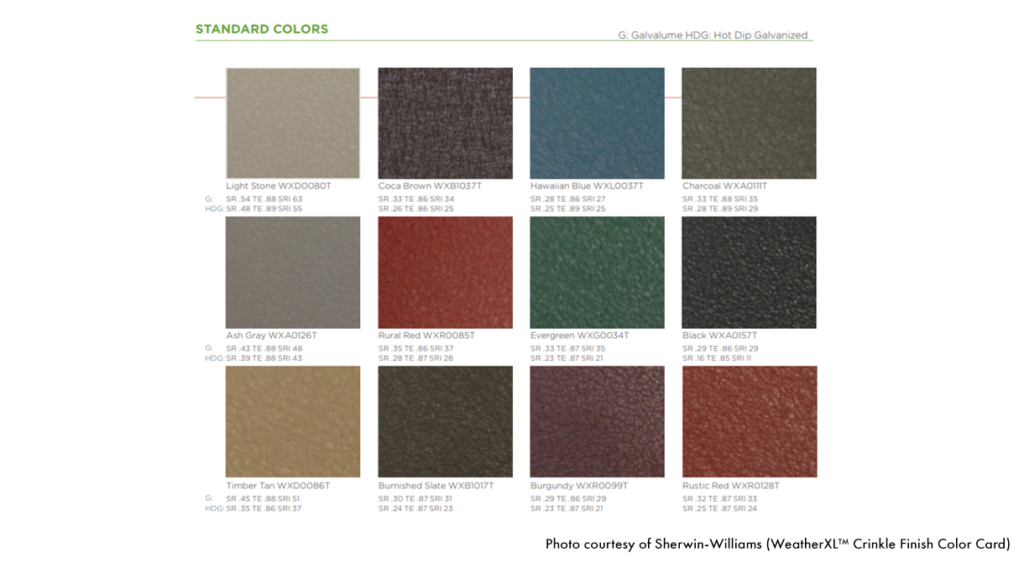
Another reason SMP is experiencing growth in the architectural metals industry is that textured finishes, such as Sherwin-Williams’ WEATHERXL™ CRINKLE FINISH or AkzoNobel’s CERAM-A-STAR®, are formulated with SMP paint systems. Textured finishes are unique because they provide an enhanced visual depth on flat panels that you don’t get from solid colors. Plus, it can help minimize the appearance of oil canning, which can occur with flat standing seam panels.
Best of all, these textured paint systems are typically applied to 26 or 24-gauge Galvalume, so it becomes more in line with architectural standing seam system requirements.
Disadvantages & Cons of SMP Paint Systems
Lower color integrity
The main disadvantage of an SMP paint system is that it will likely chalk and fade more than a PVDF system, especially if exposed to significant sunlight/UV rays.
The color pigments in SMP systems break down in less time because the chemical bonds in the silicone-modified polyester resin are not as strong as a polyvinylidene fluoride formula, leading to the color’s fading. The same goes for chalking; as the SMP resin breaks down and loses adhesion to the surface, the particles will turn white, and the chalking will become more apparent.
However, it’s important to remember that all painted metal will experience chalking and fading to some degree.
Less chalking & fading coverage
While the film adhesion on SMP is covered for 40 years, chalking and fading (up to a specific point) are only covered for 30 years. What you can see in the comparison chart above is that SMPs have different chalking and fading ratings for roof panels than PVDF systems, both of which are less-performing numbers. In essence, this means that SMPs are expected to chalk and fade more within 30 years than PVDF systems. We recommend reading the fine print of a finish/paint warranty to understand how coverage changes based on the paint system.
Not recommended for bright, vivid colors
Due to the higher level of fading and chalking with SMP panels, bright and vivid colors aren’t usually recommended. Bright colors like reds, blues, and greens will noticeably fade differently than lighter grays or beiges. That’s why many suppliers’ SMP offerings have more earth tones or lighter colors that will better maintain the aesthetic of your roofing system. Brighter, more exotic colors are better suited for PVDF or FEVE type systems because their resins protect the color pigments for more extended periods.
PVDF vs. SMP: Which Is Best For Your Project?
To help you better choose the best paint system for your project, here are some scenarios that you can use as a baseline to measure which coating is suitable for your specific situation.
Colors & Finishes
- You want a bright, vivid, or vibrant color.
- Best paint choice: PVDF
- You want an Earth tone, lighter color, or muted tone.
- Best paint choice: SMP or PVDF
- You want a textured finish.
- Best paint choice: SMP
- You want or require a cool metal roofing system with a high SRI value.
- Best paint choice: PVDF
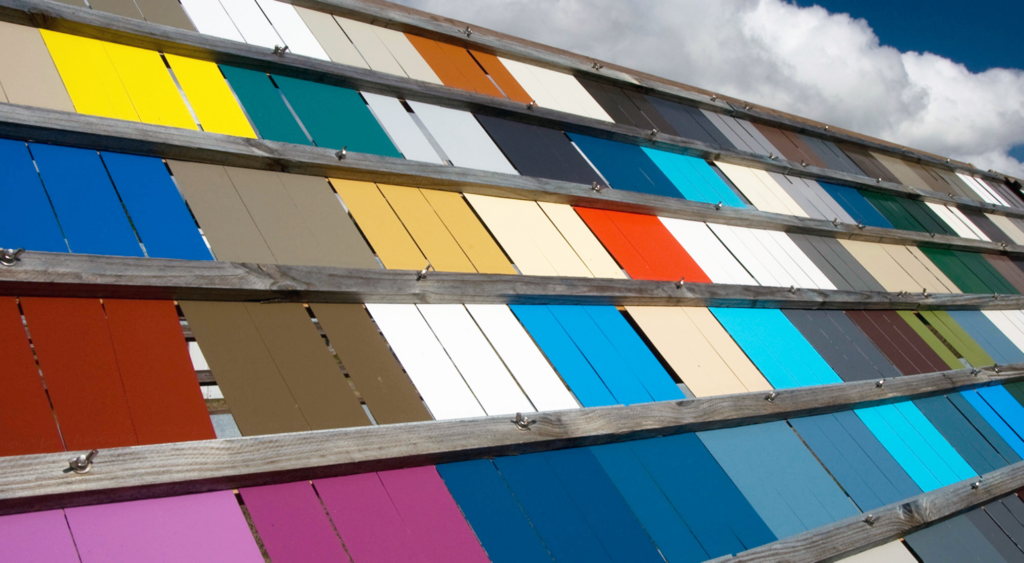
Performance
- Your project is in an area with significant sun exposure.
- Best paint choice: PVDF
- Your project is in a mild environment.
- Best paint choice: SMP or PVDF
- You want a paint system that will maintain its color for decades without much fading.
- Best paint choice: PVDF
Warranties
- You want a warranty with superior film adhesion coverage.
- Best paint choice: SMP or PVDF
- You want the best chalking and fading coverage in your warranty.
- Best paint choice: PVDF
- You’re not as concerned about chalking and fading coverage.
- Best paint choice: SMP
Price & Cost
- You don’t want to spend a lot on your metal roof or have a limited budget.
- Best paint choice: SMP
- You are willing to spend more on a metal roofing system or have the budget for it.
- Best paint choice: PVDF
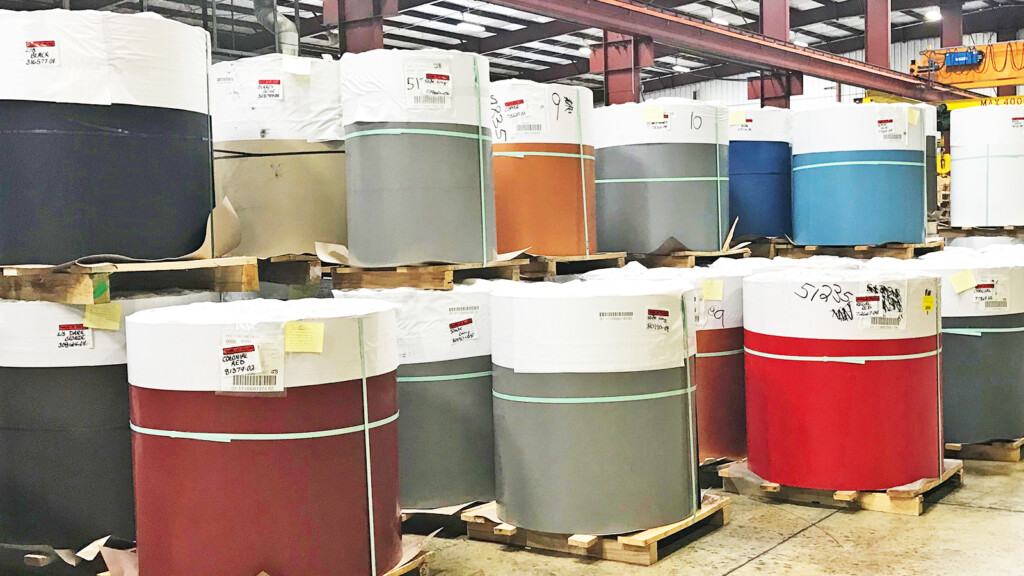
Final Thoughts on PVDF vs. SMP Paint Systems
PVDF and SMP are both great coating options — there’s no question about it. However, the best or right choice relies on your specific needs and expectations for your standing seam metal roof.
To assist in the decision-making process, make sure you consider the following:
- Your project’s budget
- Your project’s location, environment, and weather patterns
- The color and tone you want
- The level of fading and chalking you’re willing to accept
- The level of warranty coverage you expect
- Product availability in your area
- What your contractor, manufacturer, or other professional recommends
For over two decades, Sheffield Metals has been helping our customers and their customers choose the paint system that is best for their projects. Whether it’s SMP, PVDF, or beyond – we’re dedicated to working with you to get the paint solution that will work best in your environment.
Have more questions about PVDF vs. SMP? Reach out to us today to discuss your paint choices with one of our knowledgeable roofing specialists.
